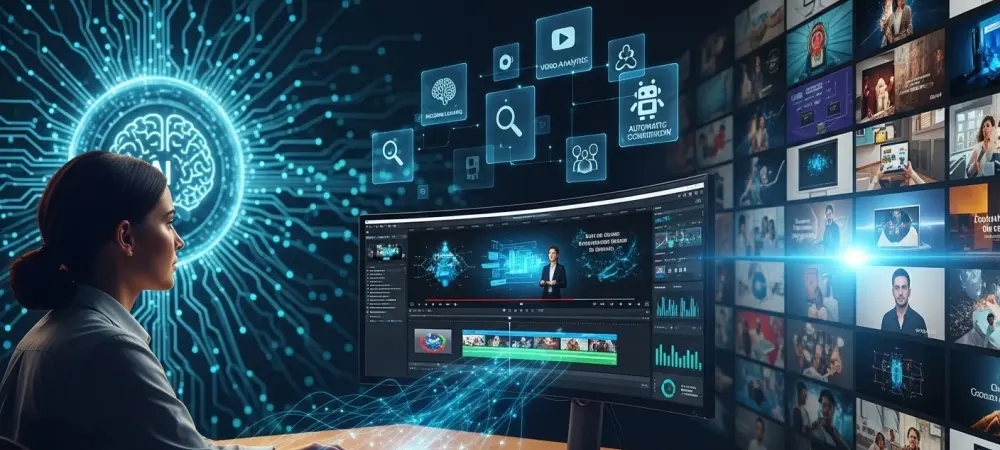In 2025, video reigns supreme as the heartbeat of digital engagement, commanding over 80% of internet traffic, and it’s clear that content marketers must adapt to this trend or risk fading into obscurity. Picture a bustling social media feed where a 60-second clip grabs attention faster than any blog post or static image ever could. For content marketers, the challenge is stark: adapt to this visual tidal wave or risk fading into obscurity. The solution lies in artificial intelligence, a tool that transforms the daunting task of video creation into an accessible, efficient process. This technology isn’t just a trend; it’s the cornerstone of staying relevant in a content-saturated world.
The Stakes Are High: Video’s Unstoppable Rise
The numbers paint a clear picture of video’s dominance. With 83% of consumers demanding video content from brands and 93% of marketers reporting robust returns on investment, the medium has become non-negotiable. Platforms like Instagram, TikTok, and LinkedIn prioritize video, pushing brands to deliver constant, high-quality output. Yet, traditional video production often drains budgets and time, leaving teams scrambling to keep pace with audience expectations.
AI emerges as the critical ally in this race. By automating editing, scripting, and even voiceovers, it slashes production timelines from weeks to mere minutes. Marketers can now focus on strategy rather than logistics, ensuring they meet the relentless demand for fresh, engaging content across multiple channels without exhausting resources.
AI Video: A Revolution in Reach and Creativity
Beyond speed, AI video tools unlock unprecedented opportunities for scale and innovation. A single blog post can morph into a LinkedIn teaser, an Instagram Reel, or a product demo with just a few clicks. This repurposing capability maximizes the value of existing content, stretching marketing efforts further than ever before.
Global accessibility adds another layer of impact. AI platforms can generate subtitles and multilingual voiceovers, breaking down language barriers and boosting SEO for international audiences. Brands no longer need to limit their reach; a campaign crafted in one region can resonate worldwide, amplifying engagement with minimal extra effort.
Real-world examples underscore this potential. Coca-Cola’s Create Real Magic campaign used AI to let customers craft branded artwork, blending technology with personal touches for trust and excitement. Similarly, Duolingo’s Video Call With Lily feature offers personalized language lessons via an AI avatar, while Nike’s recreation of a historic Serena Williams match demonstrates how AI can innovate storytelling in sports. These cases reveal how AI video maintains brand identity while driving powerful connections.
Navigating the Pitfalls of AI Video Tools
Despite its promise, AI video isn’t without hurdles. Early adopters often encounter robotic voiceovers or clunky transitions that can alienate viewers. These imperfections risk diluting a brand’s unique voice, making it sound generic or untrustworthy in a crowded digital space.
Insights from seasoned marketers highlight the importance of human oversight. Tools like StoryChief emphasize customizing AI outputs to reflect a brand’s personality, avoiding the trap of “sameness” that plagues overused templates. Starting small—testing with one video at a time—helps teams refine workflows and build confidence, ensuring the final product feels authentic and polished.
Another common challenge is integration. Adopting new technology often disrupts established processes, creating friction among team members. The key lies in gradual implementation, allowing experimentation with prompts and edits to find what works best. Persistence turns initial stumbles into long-term gains, as polished content builds audience trust.
How Brands Are Winning with AI Video
Behind the scenes, major brands showcase AI video’s transformative power. Coca-Cola’s campaign didn’t just leverage technology; it curated user-generated content with strict oversight, ensuring quality while celebrating creativity. This balance positioned the brand as a pioneer, earning loyalty through innovation.
Duolingo took a different tack, personalizing education with an animated AI character named Lily. Users practice conversations in multiple languages, experiencing tailored learning that feels both futuristic and approachable. This application proves AI video can enhance user experience while reinforcing brand values.
Nike’s partnership with AKQA studios pushed boundaries further by recreating a Serena Williams match spanning decades. This project not only captivated sports fans but also highlighted AI’s role in storytelling and analytics, setting a benchmark for transparent, cutting-edge content that resonates emotionally with viewers.
A Roadmap to Build Your AI Video Strategy
For marketers ready to embrace this shift, a clear plan is essential. Start by auditing existing content—blogs, FAQs, or whitepapers—to identify pieces ripe for video transformation. A how-to guide might become a quick demo, while a thought leadership piece could inspire an animated explainer tailored to specific platforms.
Next, define precise goals for each video, whether it’s boosting brand awareness or capturing leads. Select AI tools like Synthesia or Canva Video, ensuring they align with brand guidelines by incorporating logos and color schemes. Craft conversational scripts using AI drafts, then refine them for personality before generating and customizing the final product with branded visuals and audio.
Thorough review ensures consistency in tone and style, while distribution across channels maximizes reach. Tracking metrics like retention and clicks provides insights for future iterations. Repurposing a single video into multiple formats—trimming for TikTok or adding captions for LinkedIn—extends its lifespan, delivering more value with less effort.
Reflecting on the AI Video Journey
Looking back, the adoption of AI video by content marketers marked a pivotal shift in how stories were told and shared. Brands that leaned into this technology discovered a way to meet soaring demand without sacrificing quality or authenticity. The path wasn’t always smooth, with early challenges testing patience and creativity, but the results spoke volumes in engagement and reach.
As the digital landscape continues to evolve, the next step involves deeper integration of AI with human insight. Marketers are encouraged to experiment with emerging tools, tailoring outputs to reflect unique brand voices. Staying ahead means not just adopting technology, but mastering it to craft content that captivates and connects on a profound level.

